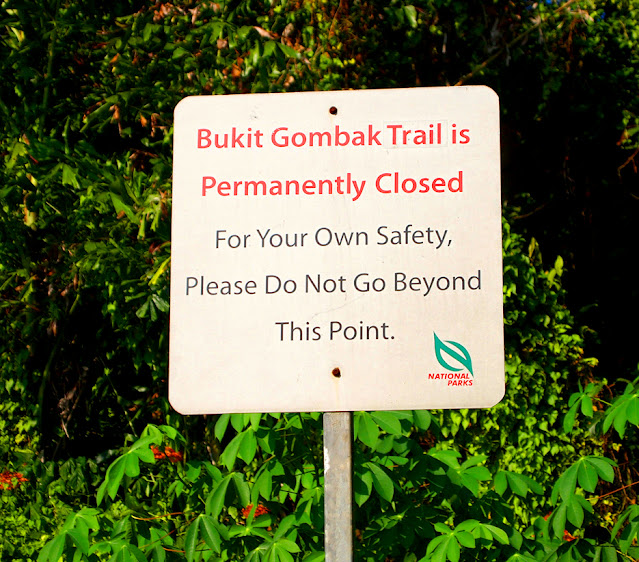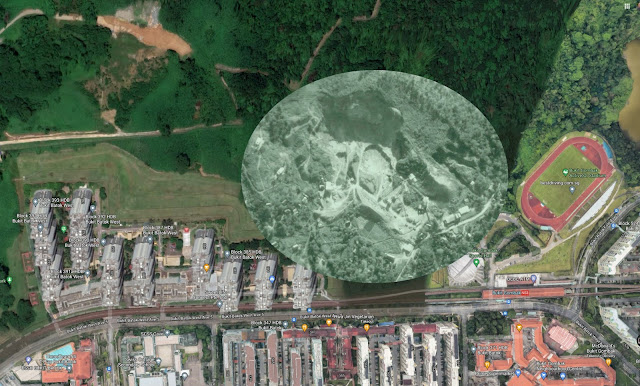It all started with the KTM railway closure. (click on link to go there)
Visiting the Rail Mall led me to Fuyong Estate and to Jalan Asas.
This then led me onwards to the old shortcut to the Singapore Quarry Park.
At the quarry park there is a plaque that reads "A Quarry story of....Chia Eng Say..."
 |
| The plaque at the Singapore Quarry Park. |
 |
| Click to read the Ode mentioning Chia Eng Say. |
Then just last night, I chanced upon a blog by a Kevin Lee mentioning a disused 'nameless' road running by Rail Mall train tracks. He wondered why it was there.
Wow, just what are all these coincidences ?
I realised the common link to them all is Chia Eng Say!
 |
| The original Chia Eng Say Road ran beside the railway truss bridge. Now abandoned and covered with detritus. |
The road ran through a Chinese kampong known to us 'locals' as Kampung Chia Eng Say.
The kampong has been demolished and the homesteaders have been resettled in HDB housing, I presume. How sad.
Two of my old schoolmates used to live in that kampong, Quek Chee Ling and Wong Bee Leng. Alas, I've completely lost contact with them after our school days ended.
I can recall visiting them often at the kampong, especially during the times when the Chinese wayangs played during some religious celebrations.
I used to lived at Fuyong Estate that was just beside the old quarry worker's kampung.
 |
| A footbridge ran from Chia Eng Say Road over the KTM railway line. This gave the kampong folks and quarry workers direct access to Upper Bukit Timah Road. |
 |
| The cul de sac at Jalan Asas. The playground on the right was where the old kampong was located. |
 |
| The secret shortcut to the quarry at the end of the cul de sac. |
Who was Chia Eng Say?
Mr Chia Eng Say was what we would call an entrepreneur today. A multi-millionaire businessman from Fujian, China, who established businesses in Penang and Singapore in the early 1900s.
He apparently lived in Katong with his large progeny, believed to be 7 sons and 15 daughters in all! Old newspaper announcements of the past had several reports of his sons and daughters being married off with grand dinners held at his mansion at Katong.
The Chia Eng Say Quarries
Chia Eng Say obtained the rights to mining the granite on the mid-western area of the Bukit Timah Ridge in the 1930s. There he started quarrying operations at two separate but adjacent sites facing the 8-1/2 milestone Upper Bukit Timah Road. The two adjacent quarries eventually merged into a single quarry. They were initially known as the Chia Eng Say Quarries.
How it became known as the Singapore Quarry was simply a matter of convenience.
Chia had set up several subsidiary companies to run his quarrying business.
The major company was called the Singapore Quarry Co Pte Ltd, and this was the firm that undertook the actual mining.
After Chia Eng Say died in 1943, the business was usually referred to as Singapore Quarry.
The name became pegged to the actual quarry site itself. Thus, the Chia Eng Say Quarries became simply known as the Singapore Quarry.
The quarry was closed when the Singapore government ordered all mainland quarrying of granite to cease in 1970.
The private road, Chia Eng Say Road, located beside the railway truss bridge, became disused over time and was later expunged. In the 1980s, NParks recovered the land as part of the Bukit Timah Nature Reserve. The quarry was to be converted into a nature park.
A new access path to the nature park quarry was formed from disused sections of the old Chia Eng Say Road.
The old name of Chia Eng Say Quarry was then replaced officially as the Singapore Quarry Nature Park.
Kampung Chia Eng Say
Chia Eng Say also built homes for his workers nearby, using the unallocated land that was beside the quarry adjacent Fuyong Estate. These were basically squatter land with temporary occupation licences given to Chia's company. Thus, colloquially, the kampung came to be known as kampung Chia Eng Say.
Chia Eng Say's legacy lives on
Besides being mentioned in the ode on the plaque, his name is now firmly entrenched nearby.
When the old shophouses at Fuyong Estate were re-developed into the Rail Mall, the little service access road in front of the shops was widened to a 2-lane road and the name Chia Eng Say Road was transferred to this upgraded stretch of road.
Trivia: In 1937, Chia Eng Say won the tender to supply all the granite to build the (old) Supreme Court building. The stones came from this quarry.

















































